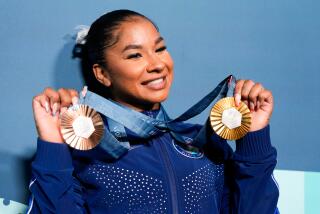THE 1987 PAN AMERICAN GAMES : Boxing : Cuban Gold Rush Is Under Way; U.S. Fighters Are 0-3
- Share via
INDIANAPOLIS — Cuba’s boxing program showed Saturday that it has shifted easily from its dominant, world-class teams of the late 1970s and early 1980s into a new era, with fighters who could rule the sport well into the 1990s.
In Pan American Games gold medal bouts at the Indiana Convention Center before a crowd of 6,675, Cuba went 5 for 5 Saturday, and it is favored in 4 of 5 bouts in today’s wrap-up session to the 10-day boxing tournament.
The Cubans were 2 for 3 against the United States and also achieved easy wins against a Canadian, a Venezuelan and an Argentine to earn five gold medals. Today, they will chase their Pan Am Games record of nine golds, set in 1983 at Caracas, Venezuela.
Cuba finished Saturday’s six-bout session with a 31-2 record for the tournament. The United States is 17-10, the improved Puerto Ricans 16-5.
U.S. boxers fought in the first three bouts Saturday, and all three lost decisions. In order:
--Light-flyweight Michael Carbajal of Phoenix tired badly in the last two rounds and lost to Puerto Rico’s Luis Rolon, 5-0.
--Cuban bantamweight Manuel Martinez earned Cuba’s first gold medal with a 5-0 decision over Michael Collins of LaPorte, Tex.
--Welterweight Ken Gould’s 4-1 decision loss to Cuba’s Juan Lemus was easily the closest of the three U.S. defeats. U.S. coaches and team officials mildly beefed afterward.
Saturday’s other three gold medalists were Cuban lightweight Julio Gonzales, who posted a 5-0 win over Venezuela’s Jose Perez; Cuban Angel Espinosa on a 5-0 over Canada’s Otis Grant; and Cuban heavyweight Felix Savon, who knocked Argentina’s Juan Diaz Nieves cold in the second round.
Today, only U.S. featherweight Kelcie Banks is a solid favorite to win a gold medal. Banks, a world champion, meets Dominican Emilio Villegas. If Banks falters, only light-welterweight Todd Foster from Great Falls, Mont., can save the United States from a gold medal shutout here. And he’s a decided underdog against a Cuban world-class stylist, Candelario Duvergel.
For the Cubans, this was a prime test of new faces. Three of the world and Olympic champions who were the heart of the great Cuban boxing teams of the past decade are retired, or about to be retired. Adolfo Horta, many times featherweight world champion, and Angel Herrera, a two-time Olympic featherweight and lightweight champion, are both coaches in Cuba’s junior program. Triple Olympic champion Teofilo Stevenson is 36, still boxing, and awaiting trial in Cuba in a fatal auto accident case.
This time, Cuban Coach Alcides Sagarra brought several new, young faces to Indianapolis. He had even replaced some of the boxers who had contributed to the winning of a record seven gold medals at the May 1986 World Championships in Reno.
Three of Sagarra’s new national team boxers won gold medals Saturday.
Martinez, a 20-year-old bantamweight about whom little was known, knocked off a three-time U.S. national champion, Collins, with little difficulty.
Lemus, only 19, shows signs of having a right hand the equal of Stevenson’s legendary punch. The powerfully built welterweight stopped three consecutive opponents, until Gould forced him to go the distance Saturday.
Gonzales, 21, wasn’t even pressed, winning decisions by 5-0, 4-1, and 5-0 to win a gold medal.
And so Cuba, a country of about 11 million people, continues to produce enough world class boxers to dominate the sport. The Cubans’ oldest boxer here is 26, light-heavyweight world champion Pablo Romero, an overwhelming favorite against Puerto Rican Nelson Adams today.
Carbajal, the silver medalist, scored perhaps the upset of the tournament, a 5-0 decision over Cuban world champion Juan Torres in the semifinals. Now, it’s back to Phoenix to his print shop job and more training in his 10-foot backyard ring.
Collins boxed an even first round with Martinez, until the Cuban overpowered the Texan with one barrage after another in the final 30 seconds. Collins began the second aggressively, but the Cuban again took charge. For the duration, he backed up Collins. All five judges gave the final round to Martinez.
Gould fought Cuba’s big puncher, Lemus, the only way he could--inside, with a furious short-range combination attack in a bout that often looked like a saloon brawl. Going in, there was a suspicion that Gould, his world champion status not withstanding, would have his head handed to him in this one.
But he put the fight where Lemus didn’t want it--in his face. The shorter-armed Gould constantly leaped past the Cuban’s jab and straight right hands to go inside, to hammer his foe inside. The question was, were his punches all scoring blows--that is, were they impacting on scoring areas (body, front and side of head) with the front, white portion of the glove?
Obviously, four judges thought not. Judges from Venezuela, Ecuador, Colombia, and Canada scored it for Lemus. Gould got only the Ecuadoran’s card. The margin on every card was one point.
Savon’s destruction of Nieves for the heavyweight gold medal indicated to some that the 6-foot 4-inch, 201-pound Cuban, who is only 19, might have Stevenson-calibre power in his right hand.
Nieves, the burly Argentine, was well on his way to the tournament’s outstanding chin award when Savon rendered him unconscious. In the semifinals, Canadian Domenic D’Amico hit him so many times on the jaw he punched himself out, and Nieves stopped him.
In the first, Savon put some right hands on Nieves’ head that drew gasps from the crowd, yet the Argentine’s knees didn’t even wobble. But with 1:12 to go in the second, Savon ducked under a Nieves left and came in with a right that would have split a door. Nieves, caught flush on the cheek, went down and stayed down.
More to Read
Go beyond the scoreboard
Get the latest on L.A.'s teams in the daily Sports Report newsletter.
You may occasionally receive promotional content from the Los Angeles Times.










